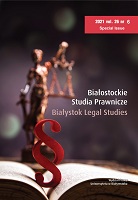Polish, and Slovak, Women in the European Parliament: an Analysis of the Results of the Election Held in May 2019
Polish, and Slovak, Women in the European Parliament: an Analysis of the Results of the Election Held in May 2019
Author(s): Dorota Lis-Staranowicz, Róbert JágerSubject(s): Gender Studies, Governance, Government/Political systems, Electoral systems, Present Times (2010 - today), EU-Approach / EU-Accession / EU-Development, EU-Legislation
Published by: Temida 2
Keywords: election law; European elections; European Parliament; gender quota;
Summary/Abstract: The objective of our paper is to analyse the political activity of Polish, and Slovak, women in EP elections; we aim to determine, among other things: whether gender quotas are a decisive factor for women’s electoral success, or do other factors result in an increase/decrease in the number of female candidates and the number of women MEPs? What are the particular characteristics of women representing Poland, and Slovakia, in the EP? What was their path to the EP? Which (conservative, liberal) parties are more willing to put women forward in EP elections? Poland introduced the so- called gender quotas into the electoral system, while Slovakia does not have such legal solutions in place. However, when comparing Slovakia to the situation in Poland, it can be stated that although there is a system of election quotas in Poland, its practical implementation may be purely theoretical. In percentage terms, the number of Slovak women elected to the European Parliament (except 2019) was significantly higher than in Poland, even though there is no quota system in the Slovak Republic. The success of Polish, and Slovak, women in the elections to the EP of the 9th term is the result of many factors, which include so-called electoral engineering (quotas, gender balance, first and second places on lists), electoral strategy of a party, but above all, political and social activity of the women themselves. We consider the last factor to be determinant in this respect.
Journal: Białostockie Studia Prawnicze
- Issue Year: 26/2021
- Issue No: 5
- Page Range: 119-140
- Page Count: 22
- Language: English

